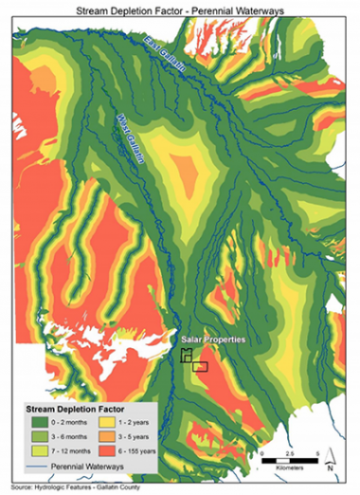In the Western United States, water rights are rigidly allocated by seniority, but over-allocation of water for agricultural, municipal, and industrial use severely depletes stream flows, degrades ecosystems, and poses economic risk to those dependent on a reliable water supply. This team investigated whether a novel approach to contractual water agreements could overturn competition between users, advance a multiple-benefit approach that restores stream flows, reduce the economic risk associated with water shortages, and maintain agricultural economies.
OUR APPROACH: This multidisciplinary team developed a suite of standardized indicators for measuring the benefits and impacts of water transaction programs.

Measuring the Benefits of Water Transaction Programs
The quantitative indicators developed by the team to evaluate water transaction programs include:
- Environmental (water in an amount, location and time to achieve conservation objectives)
- Municipal (reliable and flexible water supply)
- Agricultural (neutral or increased rural economic output as water use declines)
- Basin Drought Readiness (ability to respond to drought conditions in a watershed)
The indicators will help water managers understand and quantify potential tradeoffs and synergies among alternative water transaction strategies and programs for different water sectors. They can also provide an understanding of how water sharing agreements affect overall basin resilience to drought.
This interactive tool calculates indicator values and graphically displays how they change over time as a result of water transactions. Users may input data directly, or prompt the programs to access publicly available data such as USGS streamflow and USDA land use databases. This application allows users to enter and store data and track the progress of their water transaction programs as they work towards environmental, economic, and water security goals.

“Instead of competing over scarce water, previously competing sectors could pool financial resources to conduct fewer transactions to achieve greater overall benefits: restoration of rivers, streams and groundwater-dependent systems; assured water supplies for cities; and sustainable rural economies.”
– Eloise Kendy, Team Lead
This tool allows users to enter and store data and track the progress of their water transaction programs in achieving environmental, economic, and water security goals.
This management plan applies the concepts set forward by this SNAPP team to conduct a hydrogeological and economic analyses of the Gallatin Valley Water Exchange in Missouri’s Upper Basin.
This Journal of the American Water Resources Association paper was 1st runner-up for the 2019 AWRA Boggess Award. It describes the indicators the team developed and applied to existing water transaction programs in Oregon and Nevada.
Designed to be a holistic approach for managers from multiple sectors, this tool quantitatively measures how water transaction programs alter and improve the flow of water resources using common metrics from the fields of conservation, agricultural economics, business, industry, and municipal utilities.
The Nature Conservancy
Ecosystem Economics
University of Arizona
Culp & Kelly
The Nature Conservancy
The Nature Conservancy
US Geological Survey (USGS)
WestWater Research
City of Bozeman
The Nature Conservancy
Nevada and Central Oregon Irrigation Districts
The Nature Conservancy
National Fish and Wildlife Foundation
The Nature Conservancy; University of Virginia
Tufts University
Stanford Woods Institute for the Environment
Trout Unlimited